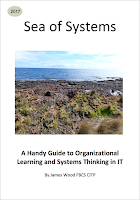Running sustained iterative design-build-test introduces the risk of becoming blind-sighted from the longer term perspective, in terms of how individual features or groups of features are expected to develop over time.
Holism sooner or later becomes elusive as smaller more frequent incremental releases can lead to release silos disconnected from the whole.
End-to-end value chains can become fragmented and the benefits promised by agile may soon be overshadowed by other challenges.
Just like every paradigm agile needs some help, especially when continual and sustained agile delivery is the goal. In the LAST (lean, agile, systems thinking) method, learning, design and anasynthesis provide a view that helps to understand sustainability.
We continue to learn, but we no longer develop or build, instead we design, and we don't analyse and plan anymore we do anasynthesis. This combination remains viable in a virtuous loop, until other internal or external forces intervene.
Explore the LAST method on Kumu through the dimensions of why, what and how - simply drag the model and tap or click on the various elements to see how they interact and support each other. Here's a link as the embed may not work reliably from the Blogger app :/ https://kumu.io/James/the-last-method
Holism sooner or later becomes elusive as smaller more frequent incremental releases can lead to release silos disconnected from the whole.
End-to-end value chains can become fragmented and the benefits promised by agile may soon be overshadowed by other challenges.
We love agile but sometimes find it difficult to see into the future
Just like every paradigm agile needs some help, especially when continual and sustained agile delivery is the goal. In the LAST (lean, agile, systems thinking) method, learning, design and anasynthesis provide a view that helps to understand sustainability.
We continue to learn, but we no longer develop or build, instead we design, and we don't analyse and plan anymore we do anasynthesis. This combination remains viable in a virtuous loop, until other internal or external forces intervene.
LAST can augment DevOps and sustained agile delivery
Explore the LAST method on Kumu through the dimensions of why, what and how - simply drag the model and tap or click on the various elements to see how they interact and support each other. Here's a link as the embed may not work reliably from the Blogger app :/ https://kumu.io/James/the-last-method


